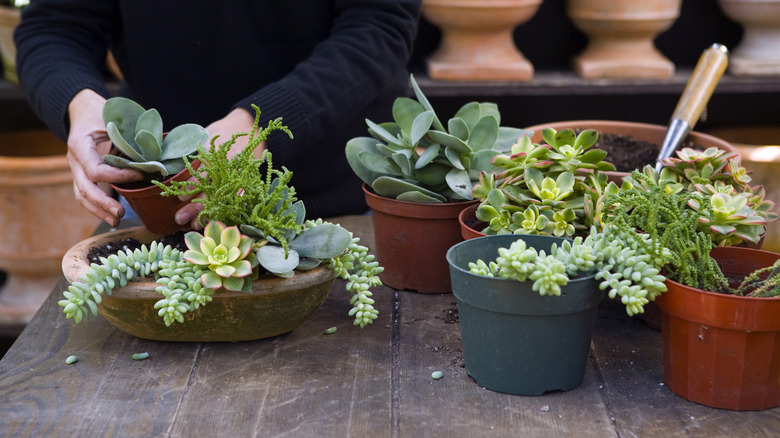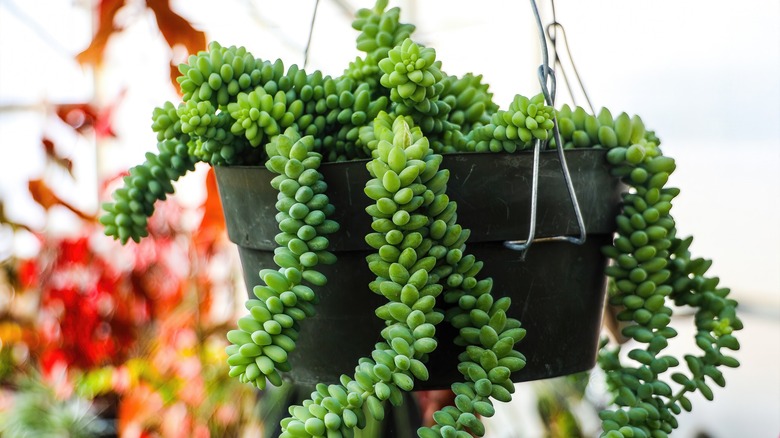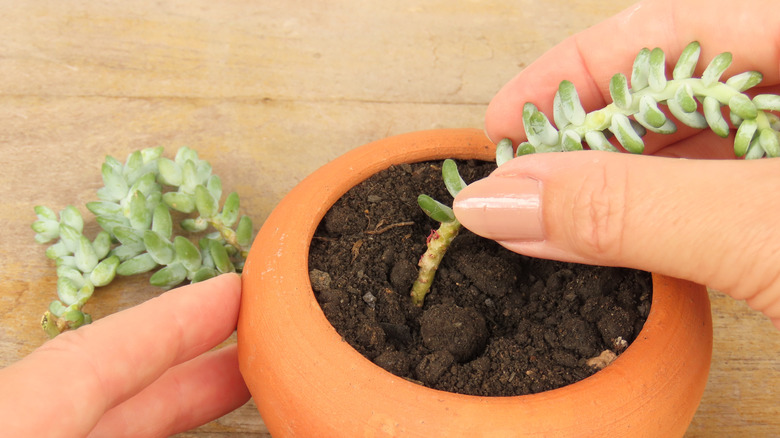Perfect Your Succulent Garden With One Low-Maintenance Flowering Addition
We may receive a commission on purchases made from links.
Whether you've turned your cracked plant pot into a stunning succulent garden or landscaped your entire backyard with succulents, cacti, and xeriscape species, you're likely constantly on the hunt for new plants to add to your ever-growing collection or replace greenery that didn't grow well for one reason or another. There's one heat-loving succulent that requires minimal care and will cascade waterfall style over the side of pots, hanging baskets, and retaining walls or out of rockery crevices, while looking ultra-cute with blue-green to silver jelly bean-like leaves and teensy pink blooms. Oh, and did we mention it's also pet-safe? The plant in question is the aptly named burro's tail.
Burro's tail, or Sedum morganianum, is an evergreen perennial that was discovered in Mexico way back in 1932 and has since become a favorite with succulent collectors and houseplant addicts alike. It even won an Award of Garden Merit by the Royal Horticultural Society in the U.K. in 1993. Burro's tail goes by a few other names related to equine and mammalian species, from donkey to horse to lamb's tail. Burro is, after all, the Spanish word for donkey and, indeed, the succulent's native range includes Mexico and Honduras. It also goes by stonecrop, a name commonly used to refer to many Sedum species. In the wild, burro's tail cascades down dry, ,steep rock faces and this trailing nature and ability to tough it out in climate extremes makes it a drought-resistant flowering plant perfect for hanging baskets. In fact, it regularly features in recommended lists of trailing houseplants.
Why burro's tail is the perfect addition to your fleshy plant collection
With branches growing up to 24 inches long, the plant resembles a jellyfish or a head full of dreadlocks. Outdoors, use it as a spiller in a xeriscape garden or large planter. The succulent boasts pretty pink-red nectar-filled flowers that pollinators love, though they'll only bloom on stems around 10 inches long. The downside for gardeners in temperate regions is that burro's tail rarely flowers when grown solely indoors. Move the plants outside in summer to encourage blooming.
Another attractive feature of burro's tail is its hardiness. It thrives in rocky and poor soils and is drought and, perhaps surprisingly for a succulent, humidity tolerant. It's rarely plagued by pests or disease. Keep an eye out for mealybugs on the branches, which, while rare, can be tricky to treat, and root rot, typically caused by overwatering. Slugs and snails may nibble on its fleshy leaves from time to time. It can be grown outdoors all year round in tropical climates — here in the U.S., that means Zones 9 to 11. But if you grow them indoors, they might stay with you for decades.
If you don't have much sun on your property or in your home, burro's tail is the perfect succulent for you. The plant prefers a bright growing spot; direct sunlight will drain the color from its leaves. Burro's tail also gets the ASPCA tick of approval for being non-toxic to cats, dogs, and horses. Don't confuse it with the other donkey's tail (sometimes also called creeping or myrtle spurge), Euphorbia myrsinites, which is a well-known skin irritant.
How to get your hands on a new burro's tail and how to care for it
You can pick up a Sprout N Green Live Fully Rooted Sedum Morganianum Succulent Plant in a 2-inch pot for just $5. If you're an impatient gardener and want to start with something a bit larger, expect to pay around $22 for a Plants for Pets Live Burro's Tail Succulent in a 6-inch pot. Be careful not to get it mixed up with lookalikes Sedum burrito (baby burro's tail) and X Sedeveria 'Harry Butterfield' (super burro's tail), which is a Sedum morganianum and Echeveria derenbergii hybrid. The former boasts rice grain-shaped leaves, while the latter is overall larger than its parent. It's also easy to propagate burro's tail from cuttings or even the leaves that so regularly break off a mature plant. Dry out the cutting for a few days to a fortnight before planting it into moist, though not boggy, soil or rooting medium and leaving it to root. You will, however, need a bit of patience; burro's tail is notoriously a slow grower.
While Burro's tail is low-maintenance compared to most plant species broadly, it's actually considered a high-maintenance succulent, mostly because it needs a good soaking every time the top of the soil dries out to keep it looking juicy. It doesn't, however, tolerate constantly wet roots, so getting watering right can be a balancing act for beginner growers. Give the plant a little fertilizer, like The Grow Co Succulents and Cactus Plant Food during the warmer months.


